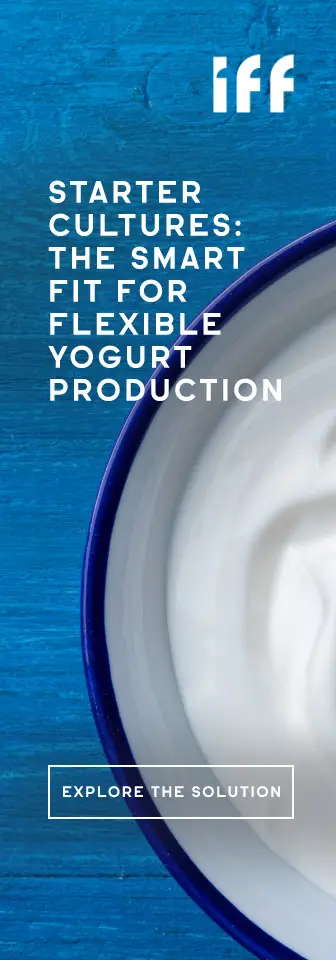ADM presents titanium dioxide alternative for intense white coloring, improving stability and texture
24 Mar 2022 --- ADM has unveiled its new line of PearlEdge proprietary white color solutions, filling a “vital white space” in the market as global manufacturers move toward phasing out titanium dioxide (E171) from formulations.
The solutions are derived from natural sources, including native corn starch, and delivers brilliant, stable and uniform white coloring for a variety of food and beverage applications.
PearlEdge is ideal for use in confectionery; powdered drink mixes and beverages; bakery icings and fillings; sugar-free offerings; soups, sauces and dressings; dairy and dairy alternatives; meat alternatives; and pet food.
“Our patent pending technology and proprietary formulas provide brands with stable, crisp white colors derived from natural sources for an array of categories. Through our vertically integrated supply chain, we’re able to control the quality of our raw materials from seed to fork,” Hélène Moeller, vice president, Global Product Marketing at ADM, tells FoodIngredientsFirst.

“PearlEdge Silk and Satin’s patent-pending technology enables a similar intensity of white color as titanium dioxide, while also helping to provide stability and improved texture,” she adds. “Notably, PearlEdge Silk and Satin can also function as an important base color for confections, to help overlayed colors pop.”
“This rollout meets the evolving needs of customers and consumers, as brands look for titanium dioxide replacements that not only provide a bright white shade, but also meet clean-label targets.”
 ADM’s PearlEdge was designed to elevate sensory appeal as an opacifying base coat for vibrant colors, creating smoother texture in certain applications.Brightness and uniformity in clean coatings
ADM’s PearlEdge was designed to elevate sensory appeal as an opacifying base coat for vibrant colors, creating smoother texture in certain applications.Brightness and uniformity in clean coatings
Available in “Silk” and “Satin” varieties, ADM’s PearlEdge was designed to elevate sensory appeal as an opacifying base coat for vibrant colors, creating smoother texture in certain applications.
“With superior stability and performance as well as a white color of similar intensity as titanium dioxide, PearlEdge Silk and Satin are game-changers for smooth white appearances in applications like panned confections and compressed tablets,” Moeller says.
“We purposefully designed PearlEdge to be an array of solutions, as we know that each application is unique and requires an individualized approach,” she continues. “For example, we use native corn starch to create our PearlEdge Silk, Satin and Shine for brilliant white confections that also have a smooth and glossy surface.”
“Plus, we leverage our proprietary emulsion technology for our PearlEdge Splash and Splash+ to act as cloud agents for beverages, creating eye-catching uniformity and opacity.”
For the beverage category, PearlEdge Splash and Splash+ activates an cloud agent for beverages, creating visually appealing uniformity and opacity. These varieties are compatible with other beverage ingredients, assuring no ringing, precipitation, sediments or staining in non-alcohol and alcohol beverages alike.
Perfecting aesthetic brilliance
ADM’s team took two years to optimize its minimally processed PearlEdge line of proprietary white color solutions.
“Our intent throughout the development process was to ensure we had the most extensive line of white color solutions that remain brilliant and stable throughout different formulation conditions, while also meeting clean-label expectations,” says Moeller.
“Our cross-functional teams and immense formulation know-how, as well as our vertical integration and global supply chain, were significant elements of our swift success,” she adds.
“Our ability to control the specifications and quality parameters of the raw materials used eliminates the need for our color scientists and technical experts to further modify the sources used for our bright white shades.”
.jpg) Crafting the ideal plant-based white colorant has historically presented formulation challenges.These developments are timely as manufacturers across Europe are racing to replace titanium dioxide in product development, in line with a new far-reaching EU ban similar to France’s 2020 barring of the additive.
Crafting the ideal plant-based white colorant has historically presented formulation challenges.These developments are timely as manufacturers across Europe are racing to replace titanium dioxide in product development, in line with a new far-reaching EU ban similar to France’s 2020 barring of the additive.
“We anticipate other markets [outside the EU] will follow suit,” says Moeller. “In fact, the State of California [US] has discussed adding titanium dioxide to its Proposition 65 rules, and we believe other regulatory bodies will take a closer look based on the EU’s lead.”
“Additionally, consumers are continually gravitating toward ingredients that they associate with natural sources, and we expect that the EU’s ban on titanium dioxide will only increase this shift in shopper behavior, putting additional pressure on brands to find alternative solutions like the PearlEdge range, which meets both formulation needs and labeling demands.”
Formulating the right white
Crafting the ideal plant-based white colorant has historically presented formulation challenges, which has propelled the development of clean label solutions to targeting brightness and purity.
Most recently, ingredient producer Blue California launched clean label whitening agents as an alternative to the potentially carcinogenic titanium dioxide.
Another example is Lonza’s Vcaps Plus White Opal, its first commercially-available titanium dioxide-free semi-opaque capsule for food supplements.
Other solutions, such as Norevo's Quick White, function by physically manipulating its ingredient’s crystal structure to reflect light in a special way that creates the color white effect.
“Current alternative sources to titanium dioxide, including modified starch, calcium carbonate and calcium phosphate, present a wide range of drawbacks, such as substandard stability, consistency and vibrancy,” notes Moeller.
For example, calcium carbonate and calcium phosphate can require extremely high usage rates to reach desired whitening, which can impact cost and negatively affect texture, she highlights. “Additionally, modified starch requires chemical modification to overcome poor solubility in cold water and high viscosity when gelatinized.”
“These alternative offerings can also complicate the manufacturing process of panned confections, as they may increase the viscosity of sugar syrup in the confection, contributing to uneven coating and texture.”
Last May, FoodIngredientsFirst caught up with key players in the coloring industry to discuss their opinions about how to move on in an E171-free space. Even while European countries have made significant efforts to curb the widespread use of the additive, other markets such as the UK – which recently refuted the European Food Safety Authority’s food safety research– remain lenient on its regulation.
By Benjamin Ferrer












